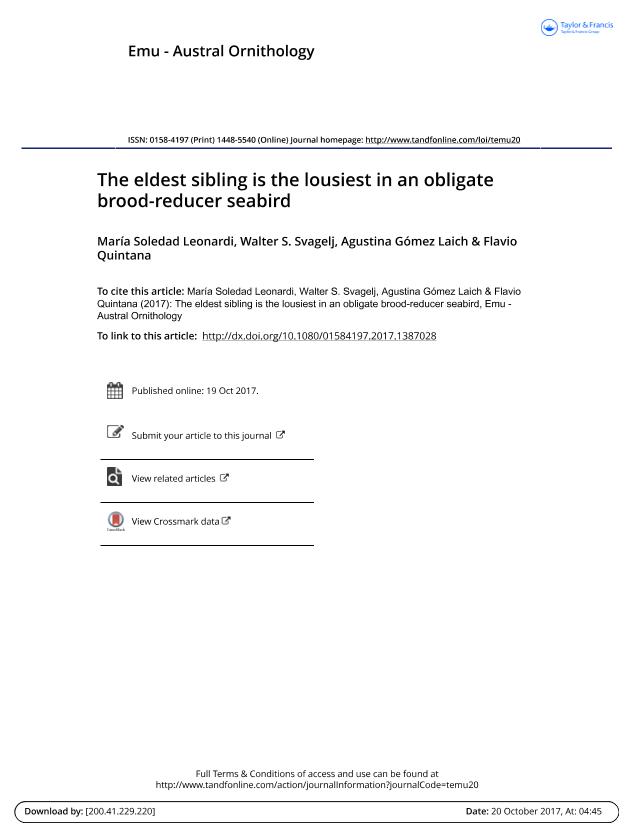Mostrar el registro sencillo del ítem
dc.contributor.author
Leonardi, María Soledad

dc.contributor.author
Svagelj, Walter Sergio

dc.contributor.author
Gómez Laich, Agustina Marta

dc.contributor.author
Quintana, Flavio Roberto

dc.date.available
2018-02-26T21:13:11Z
dc.date.issued
2017-10
dc.identifier.citation
Leonardi, María Soledad; Svagelj, Walter Sergio; Gómez Laich, Agustina Marta; Quintana, Flavio Roberto; The eldest sibling is the lousiest in an obligate brood reducer seabird; Csiro Publishing; Emu; 10-2017; 1-6
dc.identifier.issn
0158-4197
dc.identifier.uri
http://hdl.handle.net/11336/37182
dc.description.abstract
Previous studies on vertical transmission of lice on terrestrial birds have shown that the intensity of parasitism can vary within broods in relation to the hatching order of chicks. In species where the hatching order has an important effect on chick survival, lice would benefit from living on the host with the highest survival prospects. In the present work, we test this hypothesis using as model lice from the Imperial Shag, an obligate brood reducer. Our specific aims were to investigate how infestation of Eidmanniella pellucida varies in relation to the age, the order of birth and the hatching date of chicks. We observed that chicks were infested by their parents during their first days of life, mainly by lice in nymphal stage. The first chick to hatch was the most infested. Infestation was also affected by hatching date, increasing as the season progressed, reaching a maximum at the peak of the breeding season and decreasing gradually after that. The age of the chick was unrelated to the intensity of infestation. Our results suggest that lice would prefer the chick that is more likely to survive and highlights the adaptive strategies of lice according to the ecology of their hosts.
dc.format
application/pdf
dc.language.iso
eng
dc.publisher
Csiro Publishing

dc.rights
info:eu-repo/semantics/openAccess
dc.rights.uri
https://creativecommons.org/licenses/by-nc-sa/2.5/ar/
dc.subject
Chewing Lice
dc.subject
Host-Parasite Dynamic
dc.subject
Seabirds
dc.subject
Shag
dc.subject
Transmission
dc.subject.classification
Otras Ciencias Biológicas

dc.subject.classification
Ciencias Biológicas

dc.subject.classification
CIENCIAS NATURALES Y EXACTAS

dc.title
The eldest sibling is the lousiest in an obligate brood reducer seabird
dc.type
info:eu-repo/semantics/article
dc.type
info:ar-repo/semantics/artículo
dc.type
info:eu-repo/semantics/publishedVersion
dc.date.updated
2018-02-22T14:30:50Z
dc.identifier.eissn
1448-5540
dc.journal.pagination
1-6
dc.journal.pais
Australia

dc.journal.ciudad
Collingwood
dc.description.fil
Fil: Leonardi, María Soledad. Consejo Nacional de Investigaciones Científicas y Técnicas. Centro Científico Tecnológico Conicet - Centro Nacional Patagónico. Instituto de Biología de Organismos Marinos; Argentina
dc.description.fil
Fil: Svagelj, Walter Sergio. Consejo Nacional de Investigaciones Científicas y Técnicas. Centro Científico Tecnológico Conicet - Mar del Plata. Instituto de Investigaciones Marinas y Costeras. Universidad Nacional de Mar del Plata. Facultad de Ciencia Exactas y Naturales. Instituto de Investigaciones Marinas y Costeras; Argentina
dc.description.fil
Fil: Gómez Laich, Agustina Marta. Consejo Nacional de Investigaciones Científicas y Técnicas. Centro Científico Tecnológico Conicet - Centro Nacional Patagónico. Instituto de Biología de Organismos Marinos; Argentina
dc.description.fil
Fil: Quintana, Flavio Roberto. Consejo Nacional de Investigaciones Científicas y Técnicas. Centro Científico Tecnológico Conicet - Centro Nacional Patagónico. Instituto de Biología de Organismos Marinos; Argentina
dc.journal.title
Emu

dc.relation.alternativeid
info:eu-repo/semantics/altIdentifier/doi/http://dx.doi.org/10.1080/01584197.2017.1387028
dc.relation.alternativeid
info:eu-repo/semantics/altIdentifier/url/http://www.tandfonline.com/doi/full/10.1080/01584197.2017.1387028
Archivos asociados
